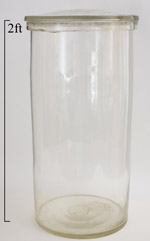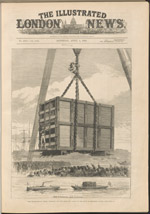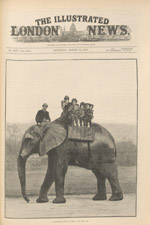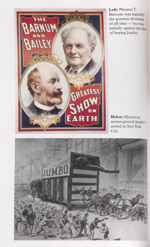Cornell’s Animal Celebrities:
Jumbo’s Heart
Jumbo the African elephant was one of the main attractions of the Barnum & Bailey Circus, “The Greatest Show on Earth.” He was billed as the biggest elephant in the world. After being captured in Africa, Jumbo spent several years thrilling crowds and providing rides in the London Zoo. The popular elephant caught the attention of P.T. Barnum and James Bailey, and after a visit to London by one of their agents, they made an offer to the London Zoo to purchase Jumbo for their circus. With much publicity and lament by the people of England, Jumbo arrived in New York City on April 9, 1882 after spending more than a week traveling the ocean in a giant crate. The fascination that had gripped thousands in England, including Queen Victoria and the young Winston Churchill, swept America. The day after Jumbo’s arrival, The New York Times dedicated a large section of its front page to the story. Barnum’s publicity machine drummed up massive public interest. In his 1888 memoirs, Barnum describes that with the first two weeks of ticket returns Jumbo “more than repaid us the $30,000 [approximately $800,000 today] his purchase and removal had cost us.” When Jumbo died in 1885, after being hit by a train in Canada, offers came in for parts of the giant’s body. Barnum gave the stuffed hide to Tufts University, who adopted Jumbo as their mascot. His skeleton was donated to the American Museum of Natural History. Cornell University paid $40, close to $1000 today, to purchase his huge heart, at the request of Burt Green Wilder, a professor of anatomy, neurology, and zoology.
 |
Specimen Jar. Whitall Tatum & Co. On loan, courtesy of Dr. Howard E. Evans and the College of Veterinary Medicine. [zoom] This jar held the heart of Jumbo the Elephant. The heart was so large that it is thought to have been compressed or partially dissected in order to fit into this huge specimen jar. The jar would have been filled with a preservative alcohol, like rum, because formalin was not in wide use as a preservative at the time. While it is unclear when the heart was discarded or possibly further dissected for study, coverage in an 1897 issue of the Cornell Daily Sun noted its immense size, but also its poor state of preservation. Initially kept in the museum at McGraw Hall, the jar was eventually moved to Stimson Hall where it was discovered empty by Dr. Howard Evans in the 1940s. Only a label identified it as the former container of Jumbo’s heart. The jar now resides in Dr. Evans’s office in Cornell’s Veterinary College. |
 |
American Medicine, February 20, 1904. [zoom] Professor Wilder used Jumbo’s heart, like most of his specimens, as a teaching and learning instrument. As this article shows, the heart alone gained national attention as a unique medical curiosity. |
 |
Illustrated London News, April 1, 1882. [zoom] |
 |
Illustrated London News, March 18, 1882. [zoom] |
 |
Paul Chambers. Jumbo: The Greatest Elephant in the World. London: Andre Deutsch, 2008. [zoom] | Additional images: 
|